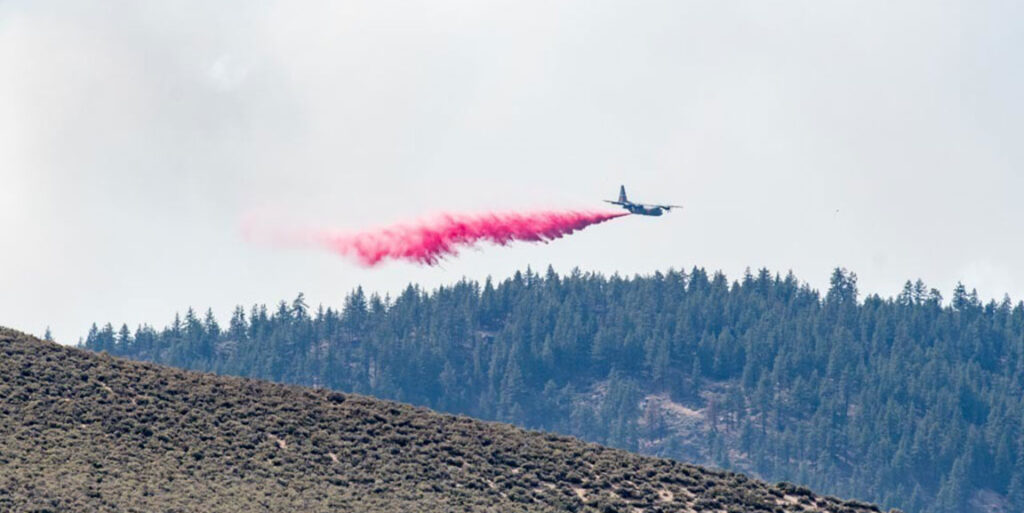An Air National Guard C-130 out of Reno, Nevada, drops retardant on the Beckwourth Complex Fire on July 9, 2021, near Frenchman Lake in northern California. U.S. AIR FORCE
THE WATCH STAFF
U.S. Northern Command (USNORTHCOM) is best known for its mission to defend the homeland from foreign adversaries, but another important mission for the command is Defense Support of Civil Authorities (DSCA). As the summer wildfire season approaches, USNORTHCOM plays an important supporting role in protecting homeland infrastructure, natural resources and human lives.
As the volatility and range of wildfires increase across the country — especially in the West — the Colorado Springs, Colorado-based air assets of the Air Force Reserve’s 302nd Airlift Wing provides critical fire-fighting support to civil authorities, coordinated through the National Interagency Fire Center (NIFC). If a blaze cannot be controlled by local or regional firefighters, the NIFC can request federal help through the Secretary of Defense, which can provide “unique firefighting assets,” according to USNORTHCOM’s website. This request is then staffed via USNORTHCOM and Air Forces North to units which include the 302nd .
“These diverse mission assets are prepared to respond quickly and effectively to protect lives, property, critical infrastructure and natural and cultural resources. Assets can include, but are not limited to, Modular Airborne Fire Fighting System equipped aircraft, military helicopters, and ground forces capable of supporting firefighting efforts. USNORTHCOM exercises operational control of those forces through its U.S. Air Forces Northern and U.S. Army North air and land components,” the website states.
In April 2024, the Air Force Reserve’s 302nd Airlift Wing prepared for the coming fire season, installing Modular Airborne Fire Fighting Systems (MAFFS) with 3,000-gallon tanks in their C-130 aircraft. The tanks allow the crews to drop aerosolized retardant on fires. Swooping low over wildfires, C-130s drop retardant that can slow down flames and help save homes, as they did during a 2013 local, Colorado fire, Lt. Col. Richard Pantusa, 302nd group chief of aerial firefighting, told the Colorado Springs Gazette newspaper. C-130s from Peterson Space Force Base are supplemented, if needed, by similar MAFFS planes from National Guard units in California, Nevada and Wyoming. Once the planes arrive at a wildfire, crews wait with their plane until weather conditions are right and ground crews are ready for them, the newspaper reported. “We are a tool in the hands of the ground crews,” Pantusa said.
As part of their preparations, 85 members of the 302nd Airlift Wing traveled to California in April to learn the latest safety and procedural methods. A six-person crew is needed to fly over a wildfire and drop fire retardant and water, according to the Gazette. Tim Russell, USNORTHCOM DSCA expert, said the command sends available C-130s. Logistics are important to providing adequate support to civilian fire crews while retaining enough planes for other command missions. “At the end of the day, we want to make sure though the capability we provide is just in time, not just in case,” he said.
The annual fight against wildfires is a key component of USNORTHCOM’s mission. USNORTHCOM Commander, Gen. Gregory M. Guillot, explained the importance of providing support for civil authorities following natural disasters in his recent remarks to Congress.
“In addition to delivering life-saving capabilities and resolute support to our fellow Americans and interagency partners in times of crisis, USNORTHCOM’s DSCA mission also routinely demonstrates a degree of resilience and well-exercised cooperation that should cast serious doubt in the minds of potential aggressors who may be considering kinetic or non-kinetic attacks against U.S. critical infrastructure. Over many years and multiple significant events, USNORTHCOM and our federal, state, local, tribal, and territorial partners have proven the ability of communities and agencies across the United States to recover quickly from major disasters. The same lessons learned in those diverse scenarios would apply following an attack against the United States, and competitors must know that an attack would be certain to fail and result in only limited disruption,” Guillot told the House Armed Services Committee in prepared testimony before a March 2024 appearance before the congressional panel.

